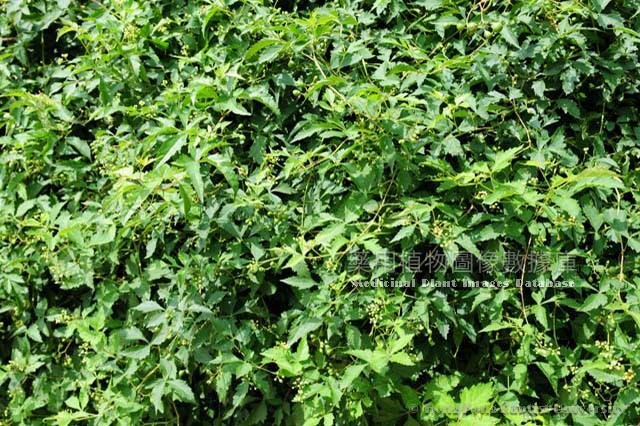|
Ampelopsis aconitifolia Bunge

|
English Name |
Monkshoodvine, Monkshood-vine |
|
Latin name |
Ampelopsis aconitifolia Bunge |
|
Family & Genus |
Vitaceae, Ampelopsis |
|
Description |
Woody vines, whole plant glabrous. Old branches dark-grey-brown, with vertical edges and lenticels; young branches slight red-purple; dendrils alternate with leaves, 2 bifurcated. Leaves palmated 3-5 divided, contour wide ovate, with long stalk; divided lobes lanceolate or rhombus-lanceolate, 3-8cm long, 1-2cm wide, apex acute, base cuneate, usually pinnately parted, lobes margin entire or with coarse teeth, above green, glabrous, below pale green, slightly pubescent along veins. Flowers bisexual, dichasium alternate with leaves, common pedicels longer than petioles; flowers small, yellow-green; calyx non-dividing; petals ovate; flower disc margin truncated; stamens 5, shorter than petals; ovary 2-chambered, style thin. Berry nearly spherical, orange or orange-red upon maturation. Seeds 1-2. Flowering: May to June, fruiting: August to September. |
|
Distribution |
Growing in thickets on mountain slopes and forest edge under altitude 1,500m. Distributed in North China, Shaanxi, Gansu, Shandong, Henan and etc. |
|
Part Used |
Medical part: root bark. Chinese name: Guoshanlong. |
|
Harvest & Processing |
Harvested throughout the year, excavated root, removed soil and fine roots, and scraped corkbark, stripped root bark, used fresh or sun-dried. |
|
Properties & Actions |
Pungent, hot.Dispelling wind and removing damp, relieving blood stasis and reducing swelling. |
|
Indications & Usage |
Anemofrigid-damp arthralgia; bruises and swelling caused by falling; swelling pain of superficial infection.Internal: decocting, 10-15g; ground into powder, 1.5-3g. External: appropriate amount, triturated for application. |
|
Examples |
Sore and furuncle: an appropriate amount of fresh root of monkshoodvine, pestle and smear onto lesions. |
|
Permanent URL:https://sys01.lib.hkbu.edu.hk/cmed/mpid/detail.php?herb_id=D00949 |
|
|

